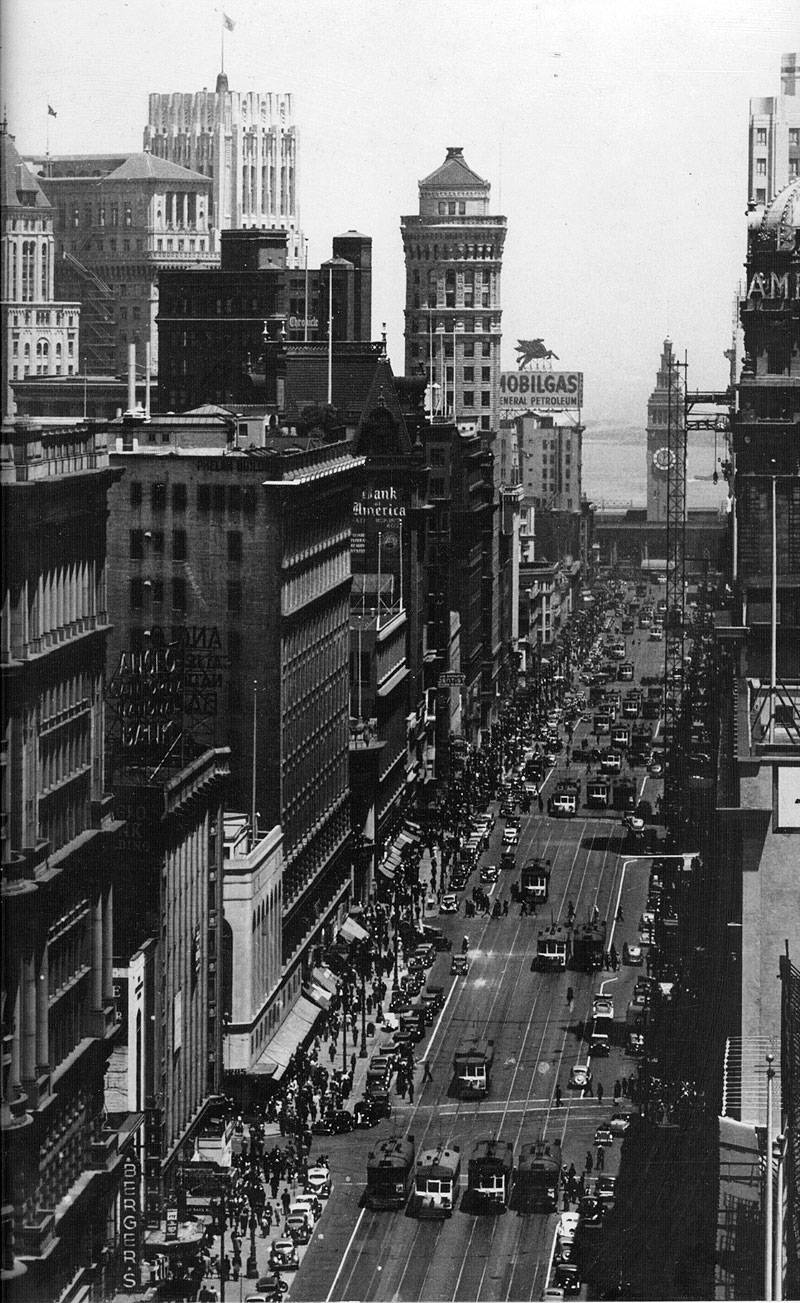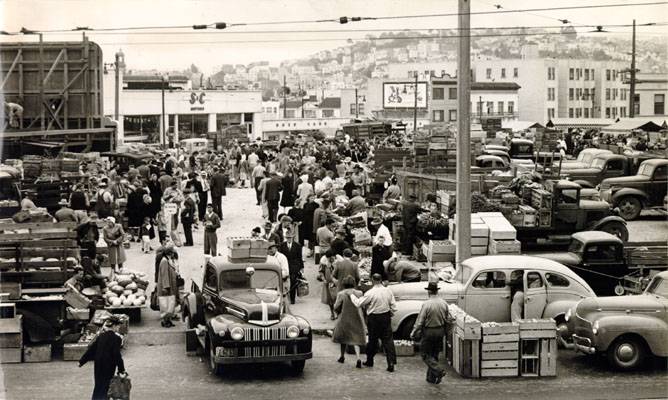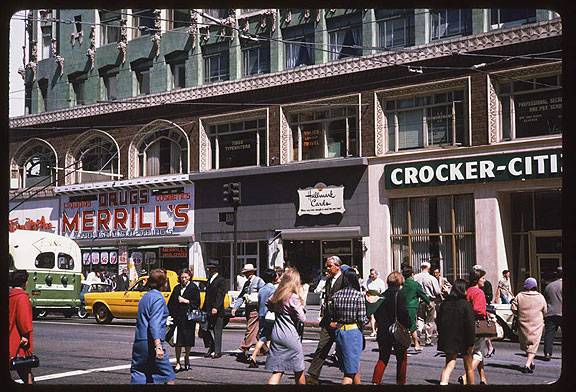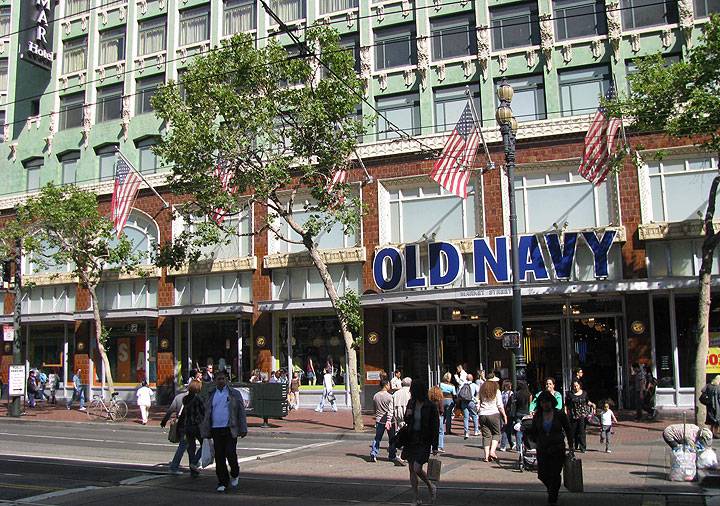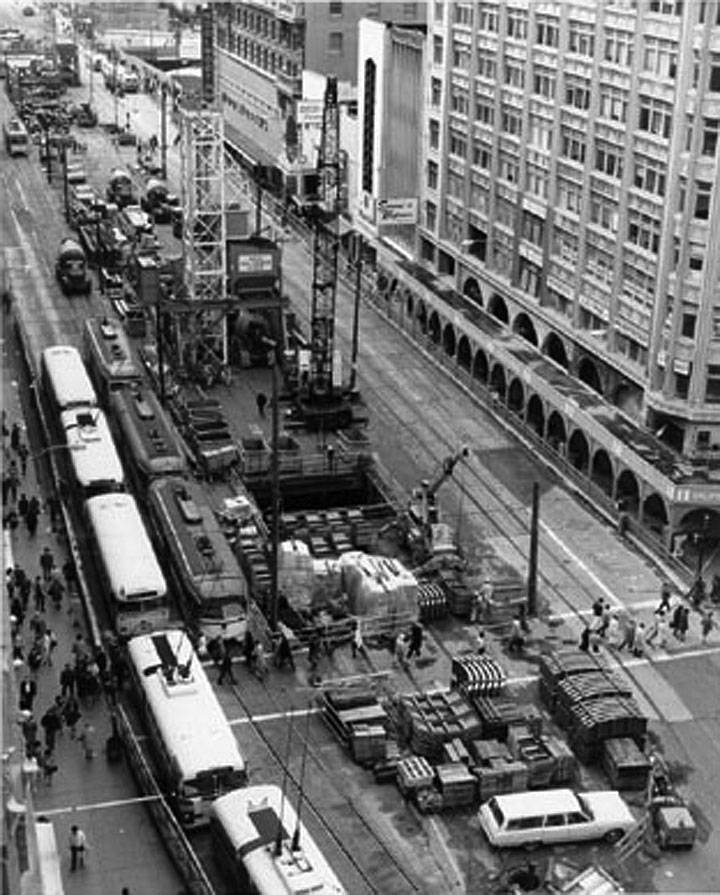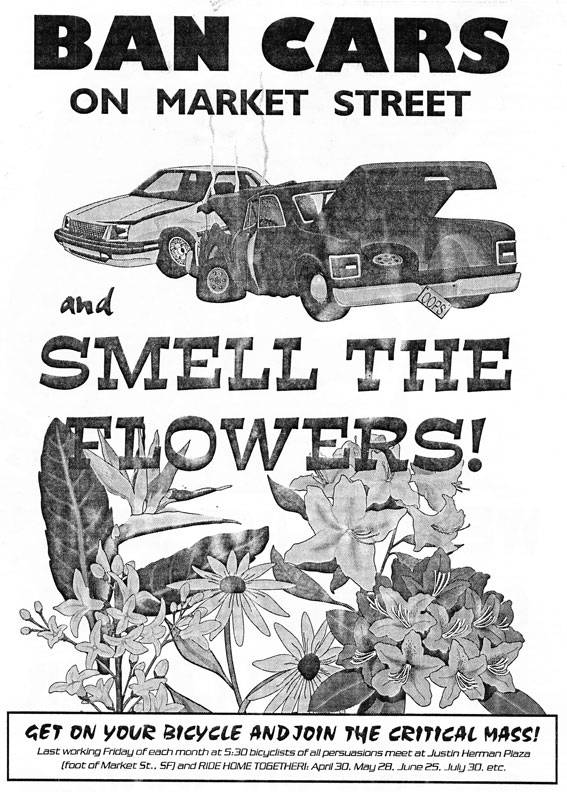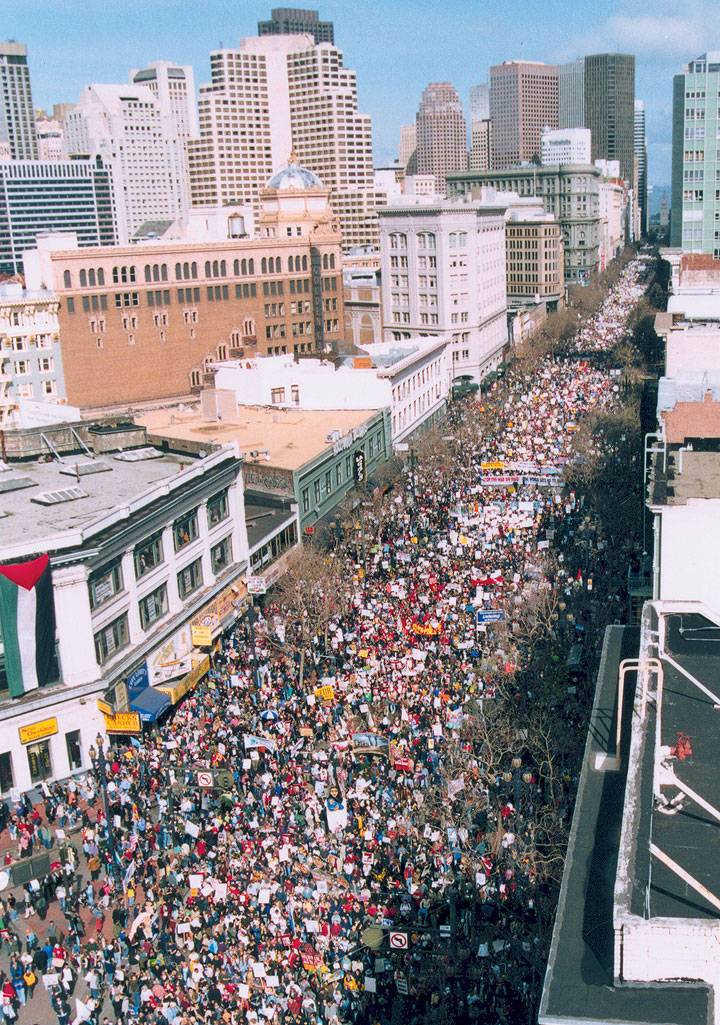Will We Ever Get Market Street Right?
Historical Essay
by Chris Carlsson
Originally published on sf.streetsblog.org on March 23, 2009
<iframe src="https://archive.org/embed/TripDownMarketStreetrBeforeTheFire" width="640" height="480" frameborder="0" webkitallowfullscreen="true" mozallowfullscreen="true" allowfullscreen></iframe>
Trip down Market Street, 1906.
Video: Prelinger Archive
Rebuilding Market Street has become a civic obsession in San Francisco. The city’s main street has been torn up and rebuilt completely at least once in every generation since the Civil War.”
—Carl Nolte, San Francisco Chronicle, July 5, 1988
Apparently it’s time again. San Francisco faces another massive effort to remake Market Street, trying one more time to get it right. What is right? Some folks harbor fantasies of a boulevard that brings out San Franciscans to re-create a life that exists mostly in our imaginations. But there is some evidence that a more vibrant and convivial street did exist in our past. An article in the long-defunct African-American journal Spokesman in 1933 described night life in the Tenderloin along Market Street:
Altogether the street is like the fairway of an enormous circus or carnival. Colors, lights, crowds, music, candy, hawkers, ballyhoo–everything is there but the elephants and the sawdust…
Market Street in 1940 with the Ferry building at the foot. Notice the multiple tracks for streetcars.
Photo: Shaping San Francisco
This photo taken around 1940 shows the old “roar of the four” as folks referred to it when four streetcar tracks, two privately owned and two public, dominated the center of the street. Cars park along sidewalks crowded with pedestrians in this image, taken midway between 4th and 5th Streets. If the view looked westerly instead of east we’d see a mid-Market full of movie palaces and locally owned small department stores and other retail outlets dependent on working class shoppers.
The city in 1940, two years before the U.S. entered WWII, was a mostly white town. Only about 2,000 African-Americans lived in San Francisco prior to the influx from the south to work in the shipyards during the war. Similarly the 1882 Chinese Exclusion Act was still in full effect, banning all immigration from China, a barrier formally lifted during the war, but it wasn’t until the 1960s that a real loosening of Chinese immigration was finally allowed.
Mid-Market, like the Mission District in the same era, was a thriving retail district. Bitter strikes had unionized much of the retail, restaurant and hotel industries by 1940. Restaurants that didn’t have a union card in the window didn’t attract patrons. It wasn’t possible to have a cup of coffee at the Owl Drug (today’s Gap) at Powell and Market without having a union waitress pour it, and a union busboy take the cup away when you were done. Quite a different era!
Duboce Farmers' Market, August 2, 1947
Photo: San Francisco History Center, San Francisco Public Library
During World War II, fruits and vegetables cultivated in farms around the region were rotting in the orchards and fields until local Italians organized a new Farmers’ Market at Duboce and Market, where the big Safeway sits now (with the Duboce Bikeway and Mona Caron’s mural behind it). That market eventually moved to Alemany, but not before San Franciscans came to depend on the arrival of fresh produce brought in from nearby counties by the farmers themselves.
Market Street has been central to the City’s self-image and basic functionality since it emerged from the mudflats of Yerba Buena Cove in the 1850s. According to Nolte’s 1988 article, the first big Market Street project wrapped up on the 4th of July, 1860 when a new steam railroad was opened for business (the railroad made sure it wouldn’t have much competition by trenching the sides of the street!). The once famous “slot” that led to today’s SOMA being known as “South of the Slot” by oldtimers was put in during the 1880s when cable cars extended their presence to many thoroughfares. The Big Earthquake and Fire of 1906 tore up the street again. Market was back up and running by 1908, but torn up in part or completely again in 1918, 1938, 1946, 1948, 1953, and then, starting in 1967, came the Big Dig for BART.
Crossing Market Street at 4th and Stockton, July 22, 1966.
Charles Cushman Collection: Indiana University Archives (P15477)
Crossing Market Street at 4th and Stockton, July 9, 2009.
Photo: Chris Carlsson
More views of the block between 4th and 3rd, south side of Market, towards the Call Building at 3rd and Market.
Looking down from the Humboldt Bank Building, west/northwest, into the hole on Market and 4th, 1969, where BART is under construction.
Photo: San Francisco History Center, SF Public Library
The entire length of Market Street was trenched several floors below the surface to build the tunnels and stations we know so well now. During the decade that it took to build the system (BART was open by 1972, but the MUNI subway tunnel dragged on for much longer, not opening until 1980. During the 1970s it was common to find blocks of Market full of bulldozers, welders, cranes, cement mixers, dump trucks, fences, piles of dirt, gravel, steel rails, railroad ties, tractors, and battalions of workers in hard hats. This was the project that killed both mid-Market and the Mission Miracle Mile (Mission Street too was gutted and trenched for several years) as go-to places for working class shopping. During this crucial era, many people were leaving San Francisco for the suburbs, and even those who stayed increasingly turned to new-fangled shopping centers at Stonestown and Serramonte where they could drive and park, rather than riding buses on unpredictable detours to get to formerly familiar stores, now buried behind plywood fences and sidewalks, dust and debris. Neither mid-Market, nor Mission Street, ever regained their previous status as important retail districts, a seemingly permanent legacy of constructing the BART system.
Curiously, when Mayor Dianne Feinstein officially dedicated a “revitalized” Market Street in 1979, it wasn’t obvious to anyone that a couple of years after the MUNI subway system finally opened the system’s planners would be back in front of the Board of Supervisors. The light rail system was now below ground, but MUNI planners were faced with a much larger downtown that drew tens of thousands more workers into the financial district every day. The light rail system could not handle the crush of riders, and MUNI successfully convinced the Feinstein administration that the glorious plans for a pedestrian-friendly boulevard full of plazas and parks, had to be rededicated to public transit. (In the early 1980 period, bicycle advocacy had nearly disappeared in the city, after some success in the early-mid 1970s.)
Thus, by 1988, Market Street was once again being transformed. Now the bus/streetcar stops in mid-street were being installed, sidewalks and crosswalks were redone, and though some suggested a dedicated bike lane should be part of the plan, the overriding priority of the city was to install the “historic” F-Line streetcars and to use Market Street for its many arterial bus routes, to facilitate transit along the corridor and to link it to Fisherman’s Wharf. After the 1989 earthquake rendered the Embarcadero Freeway unusable, the F-Line plan became a key part of remaking the entire waterfront.
The three year plan, which stretched out longer than that, eventually did lay tracks that stretch from Castro and Market all the way to the northern waterfront. The original architect of the pedestrian-and-automobile oriented Market Street that was overrun by MUNI’s surging needs (which are, after all, public needs for transit), Mario Ciampi declared that the new Market Street (the one we have now!) will be “one of the disasters of the century.” Not sure if he meant the 20th or 21st century, but it seems his prognosis has been borne out in our current public debate about the future of Market Street.
There are many reasons why a Market Street full of public spaces and an engaged population hasn’t materialized. For one thing, we’ve made it our social policy to dramatically increase the population forced to live on the streets and beg. For another, most people have had their work lives radically intensified during the past few decades, even as they’ve become more precarious and uncertain, leaving little time for a leisurely conversation on a public bench with a stranger. And that’s just the beginning.
During the past 18 years a new population has established itself on Market Street too. Bicyclists started riding in Critical Mass in September 1992, and one of the early slogans of the rides was “Ban Cars on Market and Smell the Flowers!” Since those modest beginnings, Critical Mass has institutionalized itself, usually drawing between 800 and 3000 riders on the last Friday of the month, though not always using Market Street as its main route these days (it was always a concern among many of us to avoid riding on Market for long stretches since that simultaneously slows or blocks a dozen bus lines). Now bicycles are using Market Street in almost equal numbers to private automobiles.
The street is congested, hazardous, and in poor repair. The sidewalks are wide, tree-lined, and beckoning a population that has no time to enjoy the space. Engineering the streetscape along Market encompasses questions that are much larger than merely planning a street. But it’s beyond the purview of MUNI or DPW planners to address the conditions of the sped-up, overworked, stressed out workforce, or the desperate needs of the homeless, hungry, and discarded population who often make public space more of a challenging gauntlet than a welcome respite from a mad, mad world.
This is all to say that we need a rethought and redesigned Market Street, but perhaps more importantly, we need a revitalized democratic polis, a life that is richer and more complete than what we’re stuck with, a world with less work, more equality, and a convivial commitment to a Shared City instead of a Hobbesian struggle with (false) Scarcity.
Through it all, Market Street still has its uses. This is what it looked like from the roof of the Grant Building at 7th and Market on Feb. 15, 2003, as San Franciscans came out by the tens of thousands to protest the Iraq War:
February 15, 2003 demonstration against War on Iraq in downtown San Francisco, on Market Street seen from roof of Grant Building at 7th Street
Photo: Chris Carlsson

